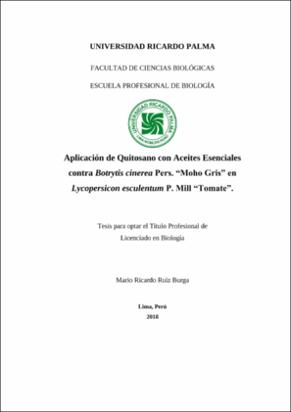“Aplicación de Quitosano con Aceites Esenciales contra Botrytis cinerea Pers. “Moho Gris” en Lycopersicon esculentum P. Mill “Tomate”.“
Resumen
El objetivo de este estudio fue determinar la eficacia de la aplicación de quitosano y aceites esenciales de Citrus aurantifolia y Origanum vulgare para prevenir infecciones por Botrytis cinerea, causante de la podredumbre gris en Lycopersicon esculentum “tomate”. Los efectos de los recubrimientos sobre las características sensoriales de los tomates también fueron evaluados. Todas las concentraciones probadas in vitro de AEOV (10 μL/mL, 5 μL/ml, 2.5 μL/mL y 1.25 μL/mL) y QUI (4 mg/mL y 8 mg/mL) resultaron en un 100% ICM para B. cinerea. Por otro lado, AECA 20 μL/mL originó valores entre 40-47% ICM. La aplicación de los revestimientos de QUI 4 μL/mL + AEOV 5 μL/mL disminuyeron significativamente la severidad de infección de la podredumbre gris en tomates artificialmente contaminados por B. cinerea. La SI en tomates tratados con los recubrimientos de quitosano y aceites esenciales fue similar o menor que la observada en los tomates tratados con fungicida sintético (Iprodione 0.8mg/mL + Myclobutanil 0.1 mg/mL). Los recubrimientos de quitosano y aceites esenciales preservaron la calidad sensorial de los tomates. Estos resultados sugieren que los recubrimientos compuestos por QUI y AEOV pueden llegar a ser un tratamiento alternativo prometedor para diversos frutos y alimentos debido a su carácter natural, la actividad antimicrobiana mejorada y al no desarrollar resistencia en los patógenos.
The aim of this study was to determine the efficacy of the application of chitosan and essential oils of Citrus aurantifolia and Origanum vulgare to prevent infections by Botrytis cinerea, which causes gray rot in tomato. The effects of the coatings on the sensory characteristics of the tomatoes were also evaluated. All concentrations tested in vitro of AEOV (10 μL / mL, 5 μL / mL, 2.5 μL / mL and 1.25 μL / mL) and QUI (4 mg / mL and 8 mg / mL) resulted in 100% MGI for B. cinerea. Otherwise, AECA 20 μL / mL originated values between 40-47% ICM. The application of coatings comprising QUI 4 μL / mL + AEOV 5 μL / mL significantly decreased the infection severity of gray rot in tomatoes artificially contaminated with B. cinerea. The IS in tomatoes treated with the combinations of chitosan and essential oils was similar or lower than that observed in the tomatoes treated with synthetic fungicide (Iprodione 0.8mg / mL + Myclobutanil 0.1 mg / mL). The coatings comprising chitosan and essential oils preserved the sensorial quality of the tomatoes. These results suggest that the coatings composed of QUI and AEOV could become a promising alternative treatment for various fruits and foods due to their natural character, the improved antimicrobial activity and to not develop resistance in pathogens.
Colecciones
- Biología [176]


